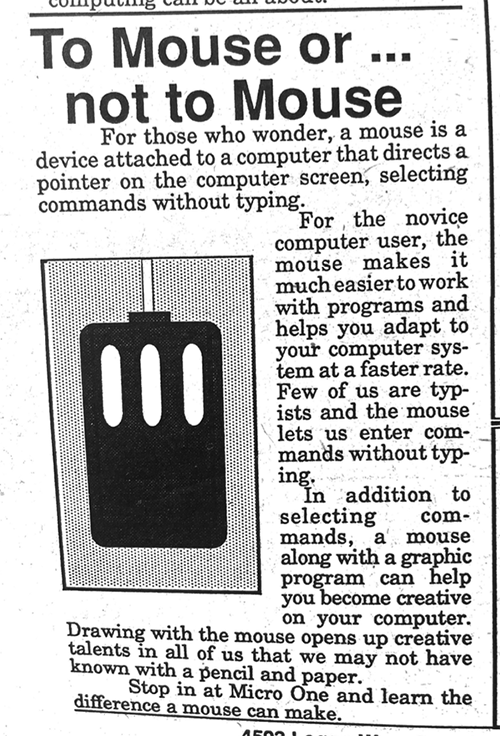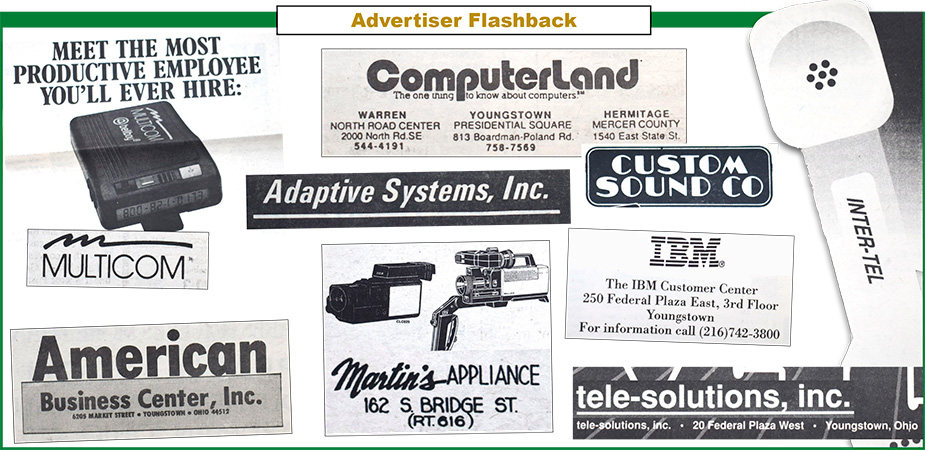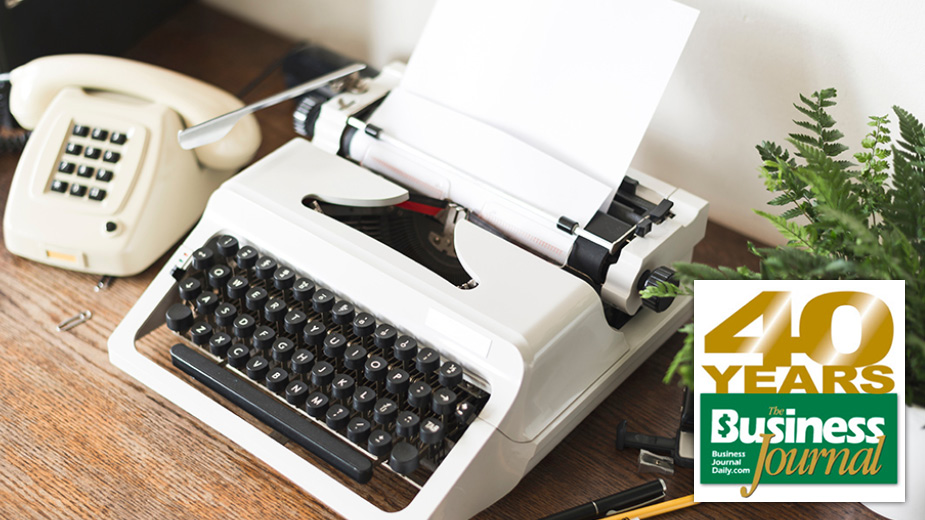YOUNGSTOWN, Ohio – An advertisement placed in the August 1984 inaugural edition of this newspaper (then the Youngstown Business Journal) touts some of the most advanced technologies available for the office workplace.
“The word processing deal that’s too good for words!” screamed the ad copy from Northeast Micro Systems of Howland. The company was marketing the Morrow MD-IE desktop business computer system, which included a monitor, keyboard, “letter-quality” printer, NewWord word processing software, and 384k floppy disk memory. The all-inclusive package at the time sold for $1,449 – equal to $4,375 in today’s dollars.
And the 384k of floppy disk space? That amount of elbowroom today would not be able to squeeze in a digital copy of the Beatles’ White Album.
Memory in modern office technology is no longer measured in simple kilobytes. Indeed, it’s not uncommon for a desktop computer to hold a single terabyte of space – the equivalent of more than one billion kilobytes. Even more room for digital records and documents is available in what is commonly called “the cloud.”
The digital revolution has transformed the office products industry. The use of cellular phones, emails, text messages and video conferencing today is routine in the business world. These developments weren’t on most people’s radar 40 years ago.
“When I first started, we were selling mimeograph machines, duplicators and typewriters,” says Rocky Mitolo, owner of Crosby Mook Office Equipment in Warren. July 1 marked Mitolo’s 40th year at the business. The company was founded in 1911 and today sells a full line of office products that range from multifunctional copiers, computer systems and office furniture.
Mitolo says the industry in 1984 was still a good decade away from the digital age. “We sold the early word processors,” he notes. “You could type, see it on the screen, change it and edit,” he says. Simultaneously, computers were quickly making inroads with improved design and quality. “It was part of the evolution,” he says. “Once these intersected, demand slid toward computers.”
Early computers were bulky, often limited to transporting information via a dial-up modem. As chip technology improved, as well as network connectivity, companies such as Crosby Mook embraced the changes going forward.
Staying ahead of this technology was quite manageable, Mitolo says, noting that advances were introduced gradually so distributors and customers could acclimate to any learning curves.
“It was relatively easy keeping up,” Mitolo says. “Over a 40-year span, it came in at little bits at a time.”
Still, during the 1980s, local office equipment dealers and communications companies – and their customers – were clearly doing their best to keep up with emerging technologies.
A full-page advertisement in the November 1988 edition of this newspaper was placed by Wilcom Cellular One, the first local provider of what was then groundbreaking technology: wireless communications. The locally owned company – founded just three years earlier by the late Warren “Bud” Williamson III, the former chairman of WKBN Broadcasting Co. – introduced readers to the latest devices in wireless.
Described as “personal communication specialists,” Wilcom Cellular marketed new products such as pagers and two-way radios.
There was another product in the company’s portfolio as well – cellular phones, making Wilcom Cellular a pioneer in this emerging field. Wilcom eventually became Signet Wireless Inc. In 1998, Dobson Communications Corp. acquired the wireless service for $337.5 million in cash.
During the late 1980s, other local businesses saw how technology integrated into their operations. A local CPA firm in our November 1988 issue advertised how its “portable computers can solve your accounting problems.” Other companies advertised training and education seminars to assure those who might be ‘afraid’ of using one.

There is even a section of an advertisement describing in detail precisely what a mouse is and how that computer appendage works.
As the decade of the 1980s closed, businesses like Computerland were selling brands such as Apple, IBM and Compaq – standard names across the industry today.
More common, though, were business equipment dealers that hyped what were then the stalwarts of the trade – electronic typewriters, personal copiers and the facsimile machine.
The facsimile machine, or “fax,” arrived sometime during the middle of the 1980s. It became commonplace in offices by the end of the decade. Technology had made it possible for one party to transmit images or documents via an analog telephone line to another party with a fax terminal.
Although the technology may seem dated, the fax machine is hardly an anachronism, says Thomas Reeveley, president of Team Office Technologies, Austintown.
“It’s one of those things, from a tech standpoint, that they say is going away,” Reeveley says. “But they’re used regularly.”
Team Office today manages office networks, security, equipment, compliance and other technical matters that affect the workplace. “We call it complete IT,” he says.
Some professions – the medical industry specifically – require documents transmitted by fax to comply with the Health Insurance Portability and Accountability Act, or HIPAA, Reeveley says. Court systems still do a significant amount of faxing. Although some analog machines remain in use, most facsimile technology uses what is called fax over IP, in which the analog signal is converted and encrypted to digital or vice versa.
“We have clients that fax thousands of documents a day,” Reeveley says. “Digital faxes use better encryption technology, a much faster transmission speed, a much higher reliability rate, and a much better image quality than the old analog machines.”
Analog equipment often required certain tweaks and adjustments to arrive at an acceptable quality, Reeveley says. “We don’t do any of that anymore. It’s just plug and play once you hook up a digital fax.”
Digital faxes also provide a record of the entire document, including transmissions that might have failed. “There’s a big advantage that way,” he says.
As with any new technology, fax machines took time to take hold, according to Bryan Blakeman, general manager of Valley Office Solutions, Boardman.
“There were some complications with those initially,” Blakeman says. “If you had one, and the person on the other end didn’t, you couldn’t send anything to them.” There needed to be widespread adoption of fax machines to boost sales.
Blakeman’s company was founded as Valley Office Equipment in 1983 by his parents, Steve and Kathy Blakeman. Throughout the last 45 years, the company witnessed the transition to the digital age.
During the early days of the company, Blakeman recalls company sales reps loading large, cumbersome copiers into the backs of station wagons so they could demonstrate them to prospective customers.“
It was that way for a pretty long time,” he adds.
He recalls the mid-1990s, as he became part of the company and computers and online services began to gain traction. “There weren’t vast networks,” he says.

As late as the mid 1990s, copy and printing machines remained unsophisticated, he says. “The big tech change then was that you could actually reduce and enlarge something,” he says. “Most didn’t provide two-sided printing options.”
The arrival of digital copiers transformed the industry. Early users still faced a challenge. “The advantage of digital copiers was that you could print directly from your computer,” Blakeman says. “The downside was that network cards at the time were $3,000 – they were very expensive.”
Nevertheless, the digital age opened new opportunities for Valley Office. Many customer companies lacked the expertise or staff to adapt this digital equipment to their networks, Blakeman recalls. “That’s how we got into the IT business,” he says.
By the early 2000s, the major issue facing office networks was not the equipment, Blakeman says, but security. As cyber threats became more commonplace, Valley Office expanded into providing network security solutions for its customers. It also developed new backup recovery systems to retrieve lost data in the case of a breach or emergency.
Among the last major changes in the industry came with the pandemic. “When people started working from home, we had to pivot again and start offering solutions that were hybrid-based,” Blakeman says.
Over the last 40 years, Valley Office has evolved from an office supply store to a comprehensive IT management firm, Blakeman says.
And what of that long-lost office staple and workhorse, the typewriter?
“We still sell them,” says Crosby Mook’s Mitolo. “There are only one or two manufacturers left. So there are supply issues. But if we can get them, we can sell them.”
